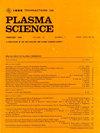真空灭弧器中电极表面温度和弧后电流的测量
IF 1.3
4区 物理与天体物理
Q3 PHYSICS, FLUIDS & PLASMAS
引用次数: 0
摘要
在真空灭弧器中,由于短路电流中断产生电弧,在电流为零后,等离子体仍留在电极之间。这种由离子、电子和金属蒸气组成的残余等离子体影响短路电流中断后的绝缘恢复过程。离子和电子密度可归因于弧后电流和电极表面温度。因此,直接测量弧后电流和电极表面温度对于了解短路电流中断后绝缘恢复过程至关重要。在本研究中,将螺旋电极原型安装在真空室中,测量了电极表面温度和弧后电流。电极采用Cu-Cr材料,中断电流在10-24 kArms以上。采用双色高温计法对电极表面温度进行了二维测量。在20karms以上,随着中断电流的增大,融化面积增大。弧后电流及其电荷也随断流的增大而增大,但其增大幅度不如熔面积大。本文章由计算机程序翻译,如有差异,请以英文原文为准。
Measurement of Electrode Surface Temperature and Post-Arc Current in Vacuum Interrupter
In vacuum interrupters, plasma remains between the electrodes after the current zero because of arcs generated by the interruption of short-circuit current. This residual plasma consisting of ions, electrons, and metal vapor affects the insulation recovery process after the short-circuit current interruption. The ion and electron densities can be attributed to the post-arc current and the electrode surface temperature. Therefore, direct measurement of the post-arc current and electrode surface temperature is crucial for a fundamental understanding of the insulation recovery process after the short-circuit current interruption. In this study, a prototype spiral electrode was mounted in a vacuum chamber, and the electrode surface temperature and the post-arc current were measured. The electrode was made of Cu-Cr material, and the interruption current above 10–24 kArms was applied. The electrode surface temperature was measured two-dimensionally using a two-color pyrometer method. The melting area increased with an increase in the interruption current above 20 kArms. The post-arc current and its charge also increased with increasing the interruption current, but they did not increase as dramatically as the melting area.
求助全文
通过发布文献求助,成功后即可免费获取论文全文。
去求助
来源期刊

IEEE Transactions on Plasma Science
物理-物理:流体与等离子体
CiteScore
3.00
自引率
20.00%
发文量
538
审稿时长
3.8 months
期刊介绍:
The scope covers all aspects of the theory and application of plasma science. It includes the following areas: magnetohydrodynamics; thermionics and plasma diodes; basic plasma phenomena; gaseous electronics; microwave/plasma interaction; electron, ion, and plasma sources; space plasmas; intense electron and ion beams; laser-plasma interactions; plasma diagnostics; plasma chemistry and processing; solid-state plasmas; plasma heating; plasma for controlled fusion research; high energy density plasmas; industrial/commercial applications of plasma physics; plasma waves and instabilities; and high power microwave and submillimeter wave generation.
 求助内容:
求助内容: 应助结果提醒方式:
应助结果提醒方式:


